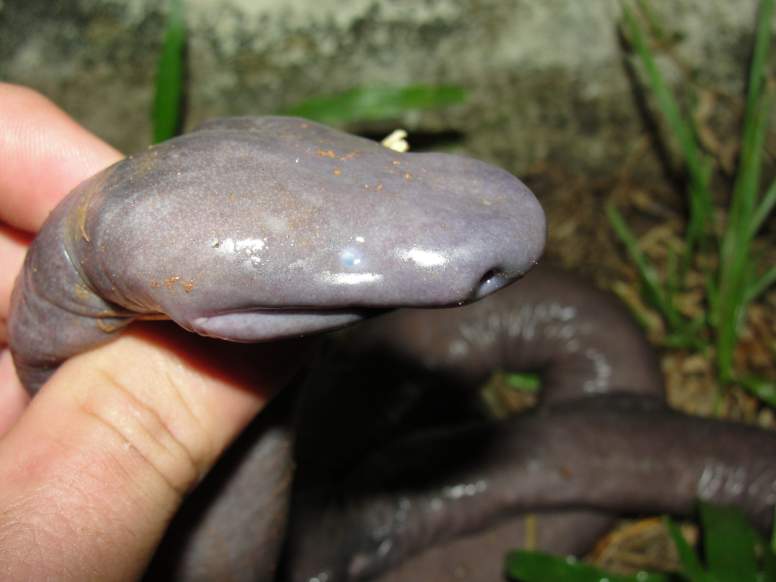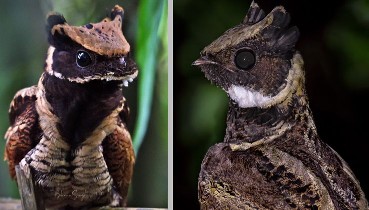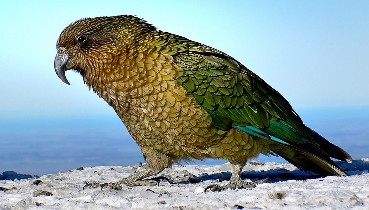
Atretochoana (Penis Snake) Facts
Two preserved specimens of the Atretochoana eiselti, originally discovered in the Brazilian rainforest, were all that were believed to exist of this rather unusual creature. Found in the late 1800s on an expedition, this species of caecilian was rediscovered in 2011 in the same region.
The ‘penis snake’ as it has since been dubbed due to its appearance, is the largest of the few known lung less tetrapods.
Its species, caecilian, is a group of limbless, serpentine amphibians that are snake like in appearance, but have rings like a earth worm.
 Photo credit Fazered via Imgur.
Photo credit Fazered via Imgur.
Atretochoana Facts Overview
| Habitat: | Rivers |
| Location: | South America |
| Lifespan: | 5 – 10 years |
| Size: | 80 cm (32 inches) |
| Weight: | 50 – 100 grams |
| Color: | Pink, purple |
| Diet: | Small fish, worms, aquatic invertebrates |
| Predators: | Large birds |
| Top Speed: | 5 mph (3 kph) |
| No. of Species: | 1 |
| Conservation Status: | Data deficient |
The penis snake is twice the size of the second-largest lung less tetrapod. It is a limbless amphibian which has a body similar to that of a snake with rings around it much like that of an earthworm. The head is broad and flat and features sealed nostrils, an enlarged mouth and a mobile cheek. There is also a fleshy dorsal fin.
Caecilians typically have a well-developed right lung along with a vestigial left lung. There are others that have two well-developed lungs. This particular species differs from these as it contains no lungs whatsoever. Capillaries fill the skin which permits the exchange of gas and there are muscles in the skull of the penis snake that have yet to have been found in any other living organism.
Caecilians usually range in size from 4.3 to 63.0 inches. The penis snake specimen from Vienna measures 28.5 inches and the Brazilian specimen is 31.7 inches in length.
The International Union for Conservation of Nature has listed the penis snake as ‘Data Deficient’ resulting from a lack of information. Scientists do feel that this animal is to be considered uncommon as its distribution is limited. It is believed to be a predator, or possibly a scavenger, and may even be viviparous.
The major threats to the penis snake include any alteration to the land they inhabit that could result in habitat loss and possible drainage of their habitat. The use of pesticides, fertilizers and other pollutants used by man may also contribute to a decline in penis snake population. Development of the habitat for hydroelectric dam projects is the current concern.
Interesting Penis Snake Facts
1. The penis snake is not actually a snake, or a penis.
Thanks to the visual similarity to a human penis, this animal has earned many nicknames. They include penis snake, manaconda and floppy snake.

2. There is no clear understanding on how the penis snake survives.
As a lung less animal, there are several challenges. With specimens being located in the Madeira River in 2011, a warm, slow-flowing body of water, scientists question how the snake breathes as warm water contains less oxygen.
3. These snakes are not believed to be burrowers as most caecilians are.
Penis snake relatives, such as the lung less salamander and other lung less tetrapods, are aquatic. As a result, it is the opinion of the scientific community that these creatures are also aquatic.
4. The name given to the genus the penis snake is classified under hints at features of the animal.
The word Atretochoana is from two Greek words. Atretos translates to mean ‘imperforate’ and choana is the word that refers to a funnel or tube shape.
5. The penis snake is considered a strong swimmer.
Coming from speculation following the witnessing of penis snakes on the surface of both the Amazon and Madeira Rivers, swimming skills are believed to be excellent.
6. Most lung less snakes rely on their skin to stay alive.
As the penis snake is not really a snake, it is not certain how it breathes. Lung less amphibians, such as the salamander, use a method known as cutaneous respiration. This is when gas is exchanged through moistened skin. Plethodontids breathe through their skin as well as the mucous membrane in the mouth. However, in order to absorb oxygen, these surfaces must be moist at all times.
7. The penis snake lacks additional features common in other life forms similar to it.
The eyesight of the penis snake is believed to be poor. However, it is capable of finding food, mates and shelter by a sensitive sense of smell.

8. Little is known on what the penis snake feeds on.
Because the penis snake is a caecilian, scientists feel that it very likely feeds on small fish, worms and other aquatic invertebrates. However, much more research is required in order to be certain.
9. Development projects in the Amazon are expected to impact the penis snake as well as other life forms in the region.
A series of hydro-electric dams are being proposed for the Amazon. Brazil has projected that a major project being undertaken there will result in thirty new dams by the year 2020. Environmentalists are critical of the project stating it will severely impact rainforest by flooding it and a national park will require rezoning prior to some construction. Ecologists fear that the dam-building project will impact fish migration and reduce nutrient flows throughout the Amazon basin.
10. The penis snake is believed to be native to just one main region and have a limited range as a result.
Found in the Amazon River and the largest tributary to the Amazon – the Madeira River – in Brazil, the penis snake has yet to have been found anywhere else on the planet. The Amazon and Madeira are white-water rivers that contain high concentrations of silt which reduces visibility considerably. Speculation points to the possibility that the creature could be found further upstream in Peru or Bolivia but there have been no sightings or discoveries as yet.
11. Although the penis snake is believed to just inhabit the Amazon River – and its tributary the Madeira River – the region is best known for a completely different kind of snake.
You’ve heard of the Anaconda snake. While it is not related to the penis snake in any way – as the penis snake is more of a worm than a snake – the Anaconda is the largest snake in the South American rainforest. Some specimens have been known to reach up to 17 feet in length. However, the smallest Anaconda can grow to about 12 feet.
Atretochoana Fact-File Summary
Scientific Classification
| Kingdom: | Animalia |
| Phylum: | Chordata |
| Class: | Amphibia |
| Order: | Apoda |
| Family: | Typhlonectidae |
| Genus: | Atretochoana |
| Species Name: | Atretochoana Eiselti |
-
Advertisements
 20 Colorful Sculptures With Intricate Details, As Created By Carol Long
20 Colorful Sculptures With Intricate Details, As Created By Carol Long Crayfish from the clear lagoon waters of the Great Barrier Reef.
Crayfish from the clear lagoon waters of the Great Barrier Reef. Land Artist Composes Beautiful Birds From Flowers And Leaves (103 Photo)
Land Artist Composes Beautiful Birds From Flowers And Leaves (103 Photo) He grew a 1.364 lbs pumpkin and then used it as a boat
He grew a 1.364 lbs pumpkin and then used it as a boat Millions Spent on Peculiar, Malodorous Flower Blooming Once Every 10 Years – Discover the Extravagance!
Millions Spent on Peculiar, Malodorous Flower Blooming Once Every 10 Years – Discover the Extravagance!








